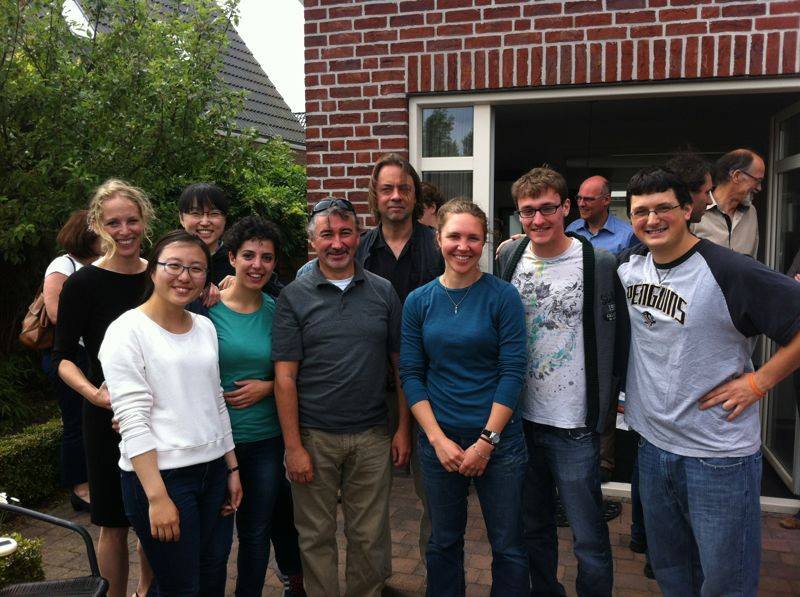 © ASTRON
© ASTRON
Summer Student Garden Party - 2013
2013 Mountainbike afternoon
 © MC/EK/AB/JvL
© MC/EK/AB/JvL
The ages ranged from <25 to >65, and the experience from looking for fun, to sporty and seasoned. The latter got a taste of some of the off-track GPS trails that Eric had previously put together. After a break a little over half way, near Hotel Spier, the second half of the course sported a steep climb onto the new bank of the A28. Then past some nice, sandy, zigzagging forest single-track back to Astron, where the PV had prepared a spread of healthy drinks and snacks, that went down well after the warm afternoon.
Thanks Alex B., Eric K. and Marja C. for co-organising.
F�ilte! - the I-LOFAR event at Space EXPO
 © ASTRON
© ASTRON
Speeches were made by Peter, Lord Rosse, and Declan Kirrane, Director of ISC Intelligence in Science (coordinator of AERAP, together with the South African Mission to the EU). Lord Rosses' speech was particularly inspiring - he noted that the great telescope of Birr (the "leviathan") that first discovered the spiral nature of nearby galaxies, was also built during a very challenging period in Ireland's history. As part of the European Space Expo programme at TCD, Dr. Anna Scaife (a LOFAR KSP member, former post-doc at TCD and a recent ERC award recipient) gave a public lecture entitled Exploring the Radio Universe with LOFAR. Various large companies were also there to show their support, including IBM Ireland - Barry O'Brian (IBM Gov. Prog. Executive) is pictured together with the AJDI author.
During the LOFAR evening event, there was a special message from Canadian astronaut Chris Hadfield who recently sprang to fame with his cover version of "Major Tom"� performed in space. Chris' daughter, Kristin Hadfield a student a TCD was present on his behalf. After the event finished, several of the participants retired to the nearby Irish pub scene, in order to consider the day's success and make plans for the future. Hopefully Peter Gallagher will visit ASTRON in the autumn, in order to continue discussions on LOFAR and to give a colloquium on some recent solar results.
SKA outreach: A Global Enterprise
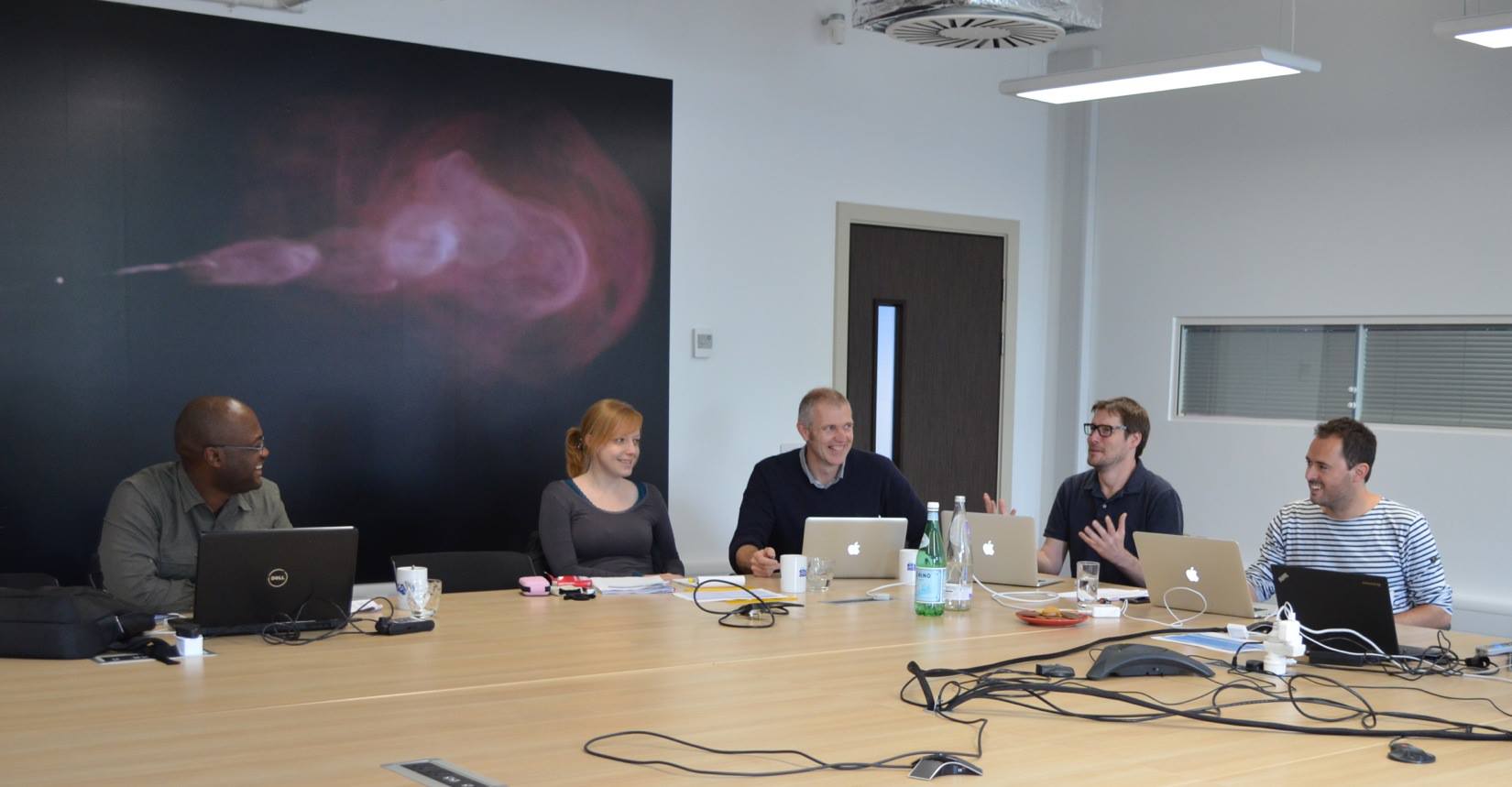 © SKA
© SKA
The SKA will be the largest and most sensitive radio telescope in the world with a total collecting area of approximately one square kilometre. The SKA will be built in Southern Africa and in Australia. It is a global enterprise bringing together 11 countries from the 5 continents. The SKA is led by the SKA Organisation, a not-for-profit company with its headquarters at Jodrell Bank Observatory, near Manchester, UK.
Of course, we want the whole world to know about this telescope, so this enormous project requires a well thought out communications strategy in which all participating countries play a role. The members of the SKA Communications and Outreach Working Group (SKACOWG, see photo) met face to face and discussed, in excellent collaborative spirit, upcoming communications opportunities such as big conferences and (outreach) events, important messages about the SKA that we want the public but also students, industry and governments to know, and the way the SKA is being branded.
Besides this group, the SKA Communications and Outreach Network (SKACON) exists, that includes outreach officers of all SKA partner countries. Both groups have regular teleconferences to keep each other up to date and to share ideas about how we can pass on our enthusiasm for the project to the outside world.
The image shows the members of the SKACOWG, from left to right around the table: Sam Rametse (SKA South Africa), Femke Boekhorst (ASTRON), Jerry Skinner (SKA Australia), Eric Chisholm (National Research Council, Canada) and William Garnier (SKA Organisation). On the phone was also Shui Min (Ministry of Science and Technology, China).
Want to know more about the SKA? Check out the website at http://www.skatelescope.org or like the Facebook pages at https://www.facebook.com/pages/Square-Kilometre-Array/121716197872910
Educational visit: students from the Electrical Engineering faculty of the Technical University of Eindhoven
 © ODIN
© ODIN
The group was welcomed and started off with a tour at the old control room and the impressive radiotelescopes at Westerbork.
Then there was a tour at ASTRON. The students were informed about JIVE and NOVA and they had the opportunity to see the R & D labs and the control room. There were also models of the new generation of radio telescopes, such as LOFAR (designed and developed by ASTRON) and SKA in which ASTRON plays one of the leading roles.
As an unexpected extra we also visited the old Dwingeloo telescope next door, responsible for the discovery of two galaxies.
See also: http://odin.ele.tue.nl/news/report-astron-excursion/#more-507
Is GBT1355+5439 a dark galaxy?
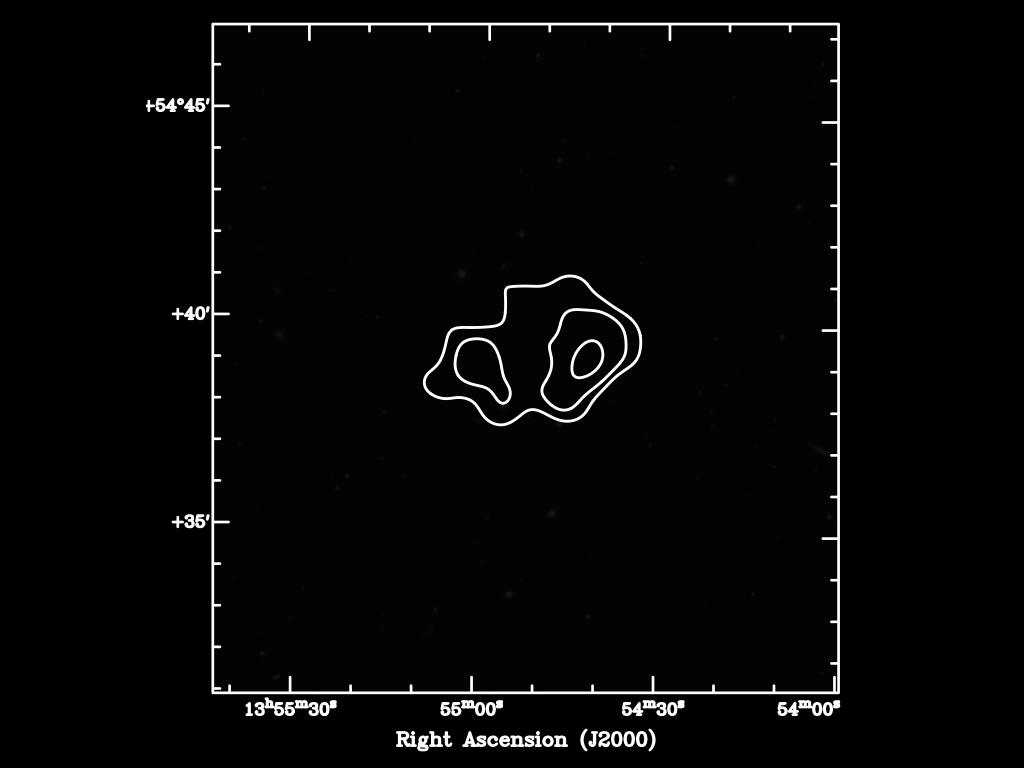 © Astron
© Astron
This may change. Last year, a mysterious gas cloud (called GBT1355+5439) with absolutely no stellar counterpart was found near the galaxy M101 by Chris Mihos and coworkers using data taken with the Greenbank telescope. GBT1355+5439 immediately caught the attention of the HI community, because you never know... Tom Oosterloo, George Heald and Erwin de Blok used the WSRT to have a closer look to see whether this cloud could be a dark galaxy.
The outcome turned out to be more interesting than expected. The conclusion is that it is very unlikely that GBT1355+5439 is a dark companion galaxy of M101. It would be loo large and too massive to be consistent with the theory of dark galaxies. However, it is not inconceivable that instead it is a (much less distant and much smaller) dark galaxy companion of our own Milky Way that happens, by coincidence, to be in the same part of sky as M101, but that has nothing to do with that galaxy. GBT1355+5439 seems to have similar properties as the objects from the population of small HI clouds recently discovered with Arecibo by, among others, Betsey Adams (who will join ASTRON after the summer as a postdoc) and that are interesting candidates for being dark (or almost dark) galaxies in the vicinity of the Milky Way. It is quite possible that GBT1355+5439 belongs to this group of objects; it would be the first one to be imaged in HI and to be studied in detail.
All this, and more, is written down in a Letter that recently appeared in A&A: http://arxiv.org/abs/1306.6148
The figure shows the HI contours of GBT1355+5439 on top of its optical image
AARTFAAC Hardware Tests
 © ASTRON
© ASTRON
The goal of the AARTFAAC project is to correlate all (288) LBA dipoles on the superterp with each other, giving 288x288/2=41.472 correlation products. With a bit of software, this represents a highly sensitive all-sky detector for transient phaenomena, i.e. astronomical sources that change in brightness (or polarization) on a relatively short time-scale.
In addition, 6 URI boards have been made for Oxford University, for their single-station correlator.
(*) URI: boards that bend data instead of spoons.
We want you as the new recruit!
 © ASTRON & SKA
© ASTRON & SKA
Snapshot Imaging and Spectroscopy of the Sun with LOFAR
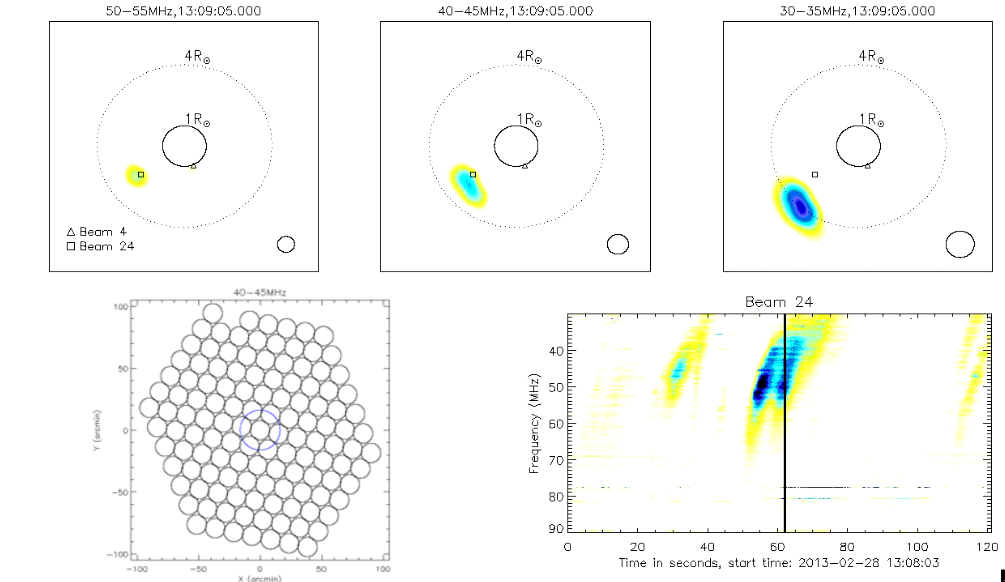 © Diana Morosan, Trinity College Dublin
© Diana Morosan, Trinity College Dublin
In February we started trialling a "snapshot" imaging mode of the Sun using the multi-beam capabilities of LOFAR. Using the core stations it is possible to form up to approximately 200 Tied-Array Beams which can be formed into concentric "rings" around the central observing direction (lower left picture - blue circle represents the Sun for comparison). These can be used to map out an area of sky, including on and around the Sun and it's corona. The advantage of using this mode to effectively image the Sun is that we can get much higher time resolution than the usual one second with interferometry, though possibly at the cost of some spatial resolution, and that a dynamic spectrum can be formed easily from the data of each tied-array beam. Having the dynamic spectra is particularly useful for identifying the type of radio burst(s) being observed.
In this observation we observed a succession of Type-III radio bursts, which are very short duration (a few seconds) bursts commonly associated with flare activity. These can be seen in the dynamic spectrum (lower right image for beam 24) as the bursts progressing rapidly from higher to lower frequency with time as they drift out through the corona. This drifting is illustrated in the top three images which were created from averages over 5 MHz in frequency and a third of a second in time, progressing from 50-55 MHz on the left to 30-35 MHz on the right. The central circle illustrates the Sun's location, the outer circle is a radius of four solar radii from the Sun for illustration purposes, and the small square to the lower left of the Sun illustrates the location of beam 24.
Who knows what LOFAR is?
 © ASTRON
© ASTRON
The foundation LofarTafel, a group of entrepreneurs in Exloo, Drenthe, is very eager to inform inhabitants and visitors about the telescope. Among other things, they organize the yearly LOFAR days in cooperation with foundation Het Drentse Landschap (owner of the nature reserve where LOFAR is located, http://www.drentslandschap.nl/) and ASTRON.
On Saturday 13 and Sunday 14 July, the LOFAR days took place in Exloo, Borger-Odoorn. Visitors participated in many activities, ranging from excursions to the telescope, previews of a theater performance about the LOFAR telescope called the LOFAR Expedition (to be premiered on 2 August), to operating a small robot made by students from the Hanze Institute of Technology.
In the field where the telescope is located, kids participated in various interactive activities to introduce them to the telescope and its technology. In addition, visitors experienced a journey through the sky in the mobile planetarium, and satisfied their hunger with "heavenly" dishes at a market with local produce. Everything was accompanied by (live) music and great weather!
Of course, the press was also there. Check out coverage on: http://www.rtvnoord.nl/artikel/artikel.asp?p=122996
http://www.rtvdrenthe.nl/nieuws/onderweg naar lofar gebied
(*) LOFAR is a next-generation giant radio telescope that consists of thousands of small antennas and is spread over most of north-western Europe. http://www.astron.nl/node/347
Evidence for jet-driven outflows of cold gas: the case of 3C293
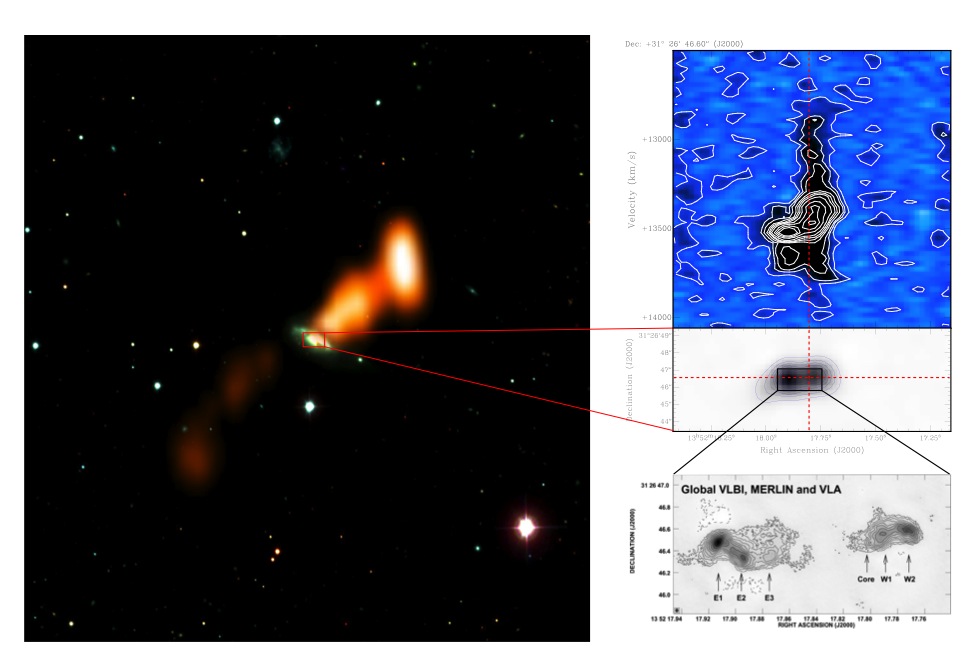 © ASTRON
© ASTRON
While fast outflows have previously been detected in this object using Westerbork (see Morganti et al., 2003), the spatial resolution of these observations was too low to accurately determine the location of the outflow. Using observations from the recently upgraded VLA we detect a fast outflow (~1200 km/s) of neutral gas approximately 0.5 kpc from the central core, suggesting that it is being driven by the radio jet. The image on the left shows the Westerbork radio continuum image of 3C293 overlaid on an optical image depicting the host galaxy. On the right is the new VLA observations where we detect the inner radio lobes on arcsec scales (middle panel) and the corresponding position-velocity diagram highlighting the broad HI absorption (top panel). A higher resolution VLBI image from Beswick et al., 2004 is shown at the bottom for comparison. The horizontal red line marks the axis along which the position-velocity diagram was extracted and the vertical red line indicates the position of the core taken from the VLBI image.
This result is presented in a paper by Elizabeth Mahony, Raffaella Morganti, Bjorn Emonts, Tom Oosterloo and Clive Tadhunter that has been accepted for publication in Monthly Notices of the Royal Astronomical Society. The preprint is also available at http://arxiv.org/abs/1307.4535 .
Studying the ASTRON/SRZM archive
 © DB
© DB
J.C. Kapteyn, the great astronomer, once described his work as "grinding huge masses of fact into law". My work can best be described as "grinding huge masses of historical record into one coherent story", which admittedly sounds less catchy. Luckily, not all of the records that I need reside in windowless basements. In addition, I talk to active and retired astronomers and science administrators, besides which I also read more general books to get a better idea of the (national and international) scientific, political, cultural and economic sides of the world in which Dutch astronomers worked.
It was great to spend a few days in Dwingeloo, experiencing the atmosphere at ASTRON and in the guest house. Those are things that can't be learned from archives, but are nevertheless relevant for the story that I want to tell. If all goes well, a Dutch-language book will appear next year. An English-language book will follow.
HI in HO: a myth debunked
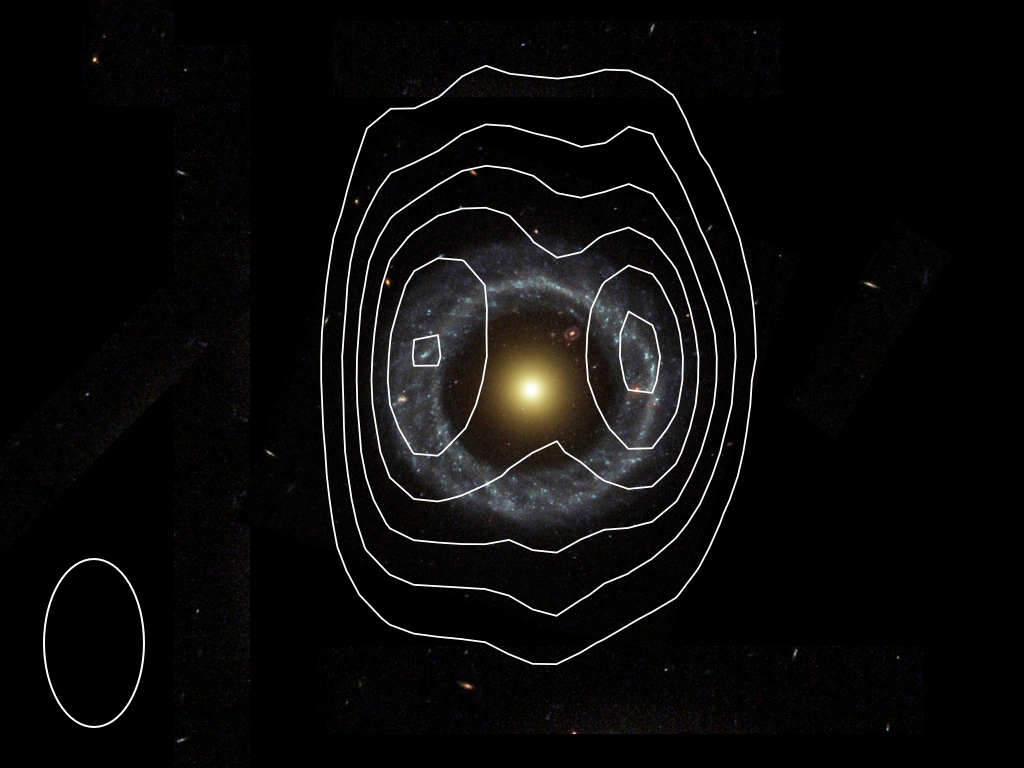 © Astron/HST Heritage
© Astron/HST Heritage
So is HO a strange object or are appearances deceiving? One way to explore the nature of a galaxy is to study the properties of the neutral hydrogen (HI) in and around it. HI has a long memory: the timescales on which the HI structures around a galaxy change are long and the HI can be used as a tracer of things that happened long ago. This is not a new idea and Noah Brosch (Tel Aviv University) used the WSRT in 1982 to try to detect the HI in HO in an attempt to unravel the nature of HO. Unfortunately, in 1982 the WSRT was not sensitive enough to detect the HI and the mystery of the nature and origin of HO was not solved.
Napoleon has told us that "la victoire appartient aux plus perse've'rants", so 30 years later, Brosch did a new attempt with, obviously, a much improved WSRT. And indeed, in the new observations the HI in HO was clearly detected. One of the key results of the new observations is that, although HO looks peculiar in the optical, from the HI point of view HO is a fairly normal galaxy.
The data show that the nice blue ring is very gas rich while the red central galaxy has no gas. The fact that the HI seems to peak at the E and W side of the ring is an observational effect due to the elongated shape of the WSRT beam at these declinations (bottom left). The HI extends slightly beyond the blue ring; in these outer regions the HI ring warps slightly from the plane of the inner ring. The HI in the ring of HO shows no signs of any recent (i.e. less than 1 Gyr) event that could have created the blue ring, consistent with earlier studies of the stellar population in the ring (Finkelman). However, there are some shreds of HI floating around, far away from HO, that may have to do something with the origin of the ring, many Gyr ago.
All these HI characteristics are observed in many early-type galaxies and the conclusion of the WSRT observations is that HO may look special, but it really isn't.
The observations and their discussion are written in the paper 'HI in HO: Hoag's Object revisited' by Brosch, Finkelman, Oosterloo, Jozsa and Moiseev that has been accepted for publication in the Monthly Notices of the Royal Astronomical Society. A copy of this paper can be found at http://www.astron.nl/~oosterlo/HIinHO/HoPaper.pdf .
The figure shows the HST image of HO with the HI intensity contours drawn on top.
Veni grant awarded to astronomer Vibor Jelic'
 © astron
© astron
Using the LOFAR radio telescope, scientists are expecting to detect cosmological radiation emitted billions of years ago, from the time of the first stars. This pivotal period in the history of the Universe is called the Epoch of Reionization (EoR). This era is key to understanding structure formation and the evolution of the Universe, and thus represents a missing piece of the puzzle in our current knowledge of the Universe. However, the faint cosmological radiation from the EoR is swamped by the foreground emission of our Galaxy and other extragalactic radio sources. Without removing the foreground emission from the data, the project team will not be able to detect the cosmological radiation and understand the EoR.
Jelic' will exploit the innovative technology and capabilities of the LOFAR radio telescope in order to conduct a first detailed study of the foreground emission below 250 MHz. A special focus will be given to the (astro)physics of the Galactic foreground emission, e.g., the peculiar polarized structures of our Galaxy and the properties of its magnetic field. The study of the foregrounds not only constitutes a very interesting and exiting field of study in its own right, but the gained knowledge will also be used to develop foreground removal techniques, helping LOFAR in the race to be the first in probing the Epoch of Reionization.
The LOFAR Expedition has kicked off!

The night started off with some heavy rain and thunder storms, which unfortunately caused a 1-hour delay. However, after the rain stopped, visitors enjoyed a fun and humourous show led by Vincent Bijlo and his 'students'. His ability to relate cosmic events to aspects in everyday life, makes the LOFAR Expedition an interesting, fun and fascinating experience. Accompanied by a live band, made up of the PeerGroup members themselves, a light show and numerous cosmic 'props', visitors were hopefully left in awe of the universe and everything that surrounds them.
LOFAR stands for Low Frequency Array and is a network of thousands of sensitive sensors spread over the northeastern parts of the Netherlands and in Germany, England, Sweden and France. One of the main projects for which scientists use the LOFAR telescope is to map the very beginning of the universe, when the first stars and galaxies were formed.
In 'the LOFAR Expedition', we travel to the origins of our universe. Vincent Bijlo thinks he has found the fastest route to the Big Bang. On the way, he makes many exciting cosmic adventures that will shed new light on our existence.
With a lot of music, humour and fantasy, the PeerGroup brings the seemingly infinte universe closer. Black holes, curved spaces and supernovas:everything becomes clear. In over an hour we travel lightyears back and who knows, maybe we'll even hear the Big Bang....
------------------
Performance dates:
Thursday 25 - Sunday 28 July at 8.30 pm (try-out)
Thursday 1 August - 8.30 pm (try-out)
Friday 2 August - 8.30 pm Premi�re
Sat 3 & Sun 4 August - 8.30 pm
Thurs 8 - Sun 11 August - 8.30 pm
Thurs 15 - Sun 18 August - 8.30 pm
Thurs 22 - Sun 25 August - 8.30 pm
More information and tickets: http://www.peergroup.nl/projecten/de-lofar-expeditie/
Location: LOFAR base, Exlo�rweg 13, Buinen (Gemeente Borger-Odoorn).
HALOGAS - NGC 5023: galactic tomography
 © Image credits: Gyula I. G. Jozsa, Peter Kamphuis, Rich Rand, George Heald and the HALOGAS consortium.
© Image credits: Gyula I. G. Jozsa, Peter Kamphuis, Rich Rand, George Heald and the HALOGAS consortium.
In the HALOGAS project we have observed 22 spiral galaxies with the WSRT, each galaxy for 120 hours. The goal is to characterise the faint, neutral gas component. It is thought that a lot more infalling gas than is observed in spiral galaxies is required to maintain star formation at the observed rates. It is therefore important to know whether the visible gas (neutral hydrogen) shows any signs of infall, and whether this correlates with other characteristics of the galaxies.
Getting a good overview means including galaxies in the sample that at a first glance seem to not be exceedingly exciting. NGC 5023 does not form many stars, and it is not interacting. However, careful kinematical modeling showed that the galaxy appears rather asymmetric. Assuming a symmetric disk, we would deduce a rather strong decline of the rotation velocity with height above the disk - a parameter that is thought to provide information about the connection between the galaxy and its atmosphere. But introducing spiral arms in our models (a possibility in the modelling software TiRiFiC), we achieve a brilliant fit, and the decline in the rotation velocity becomes much more modest.
The little animation shows first the stellar component of the galaxy, to blend with our deep WSRT observation of the neutral hydrogen. Then the modeled neutral-hydrogen component is shown (notice the good match!). We then sharpen our view to finally make the galaxy artificially opaque and to turn it around. We can visualise the (typical) spiral pattern that we believe is present in the galaxy, despite the fact that it is not immediately evident in the observed edge-on view. We are hence using the velocity information in our very deep observation to conduct a galaxy tomography.
The results are described in a paper by Peter Kamphuis et al., soon to appear in the Monthly Notices of the Royal Astronomical Society (MNRAS).
A spider's web in the early morning dew with the Dwingeloo telescope in the background
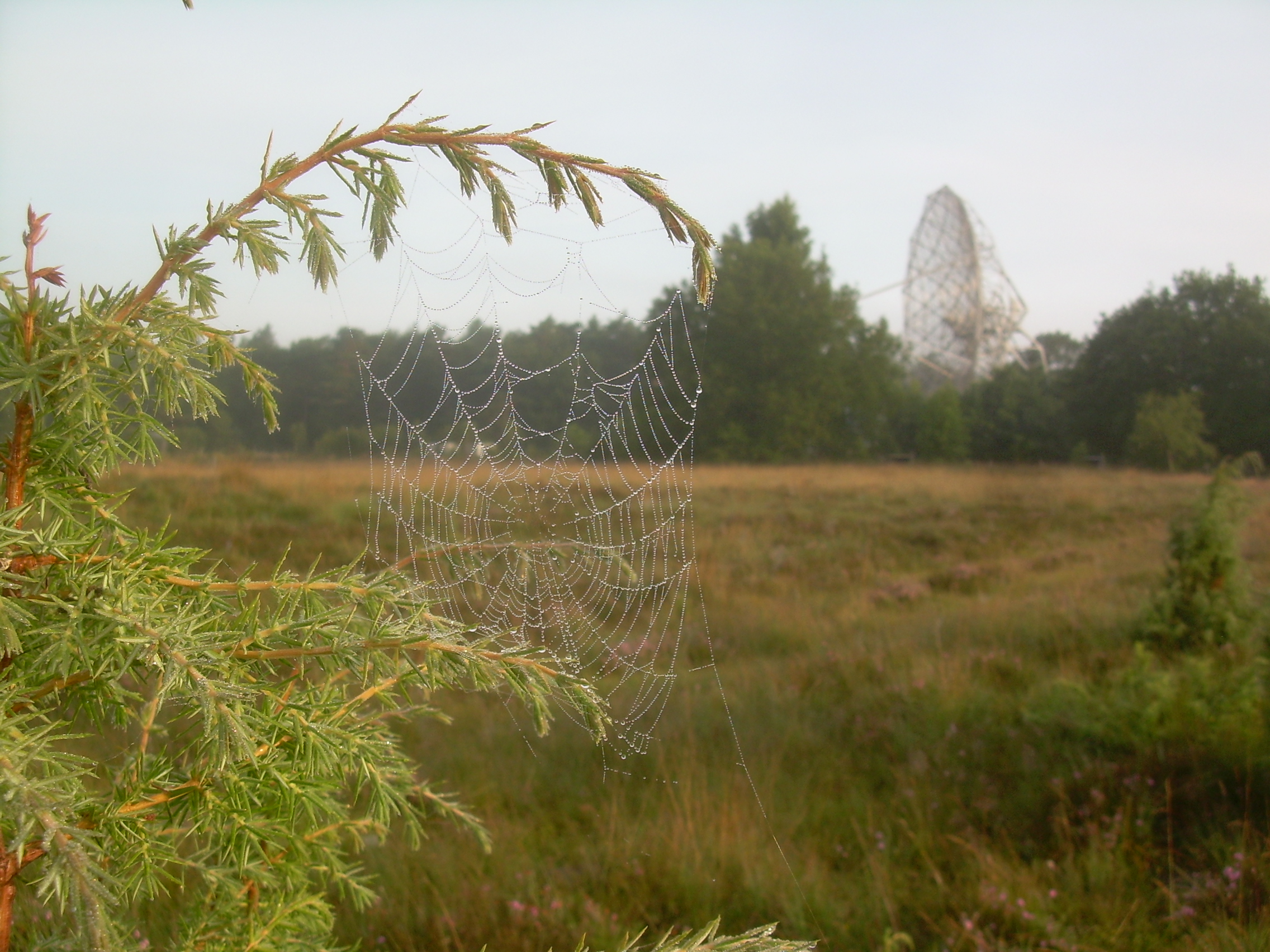
Field of Dreams (II)
 © ASTRON
© ASTRON
Pictures LOFAR Expeditie
 © H.J. Stiepel
© H.J. Stiepel
Pictures can be found at: https://picasaweb.google.com/114403768477857029527/DELOFAREXPEDITIE3AUG2013EXLOO?authuser=0&authkey=Gv1sRgCJOj84HH0oy6vAE&feat=directlink
An evening very well spent. N.B. It is still possible to attend! Performance dates:
Thurs 8 - Sun 11 August - 8.30 pm
Thurs 15 - Sun 18 August - 8.30 pm
Thurs 22 - Sun 25 August - 8.30 pm
More information and tickets: http://www.peergroup.nl/projecten/de-lofar-expeditie/
Location: LOFAR base, Exloerweg 13, Buinen (Gemeente Borger-Odoorn).
High Fidelity pays off!
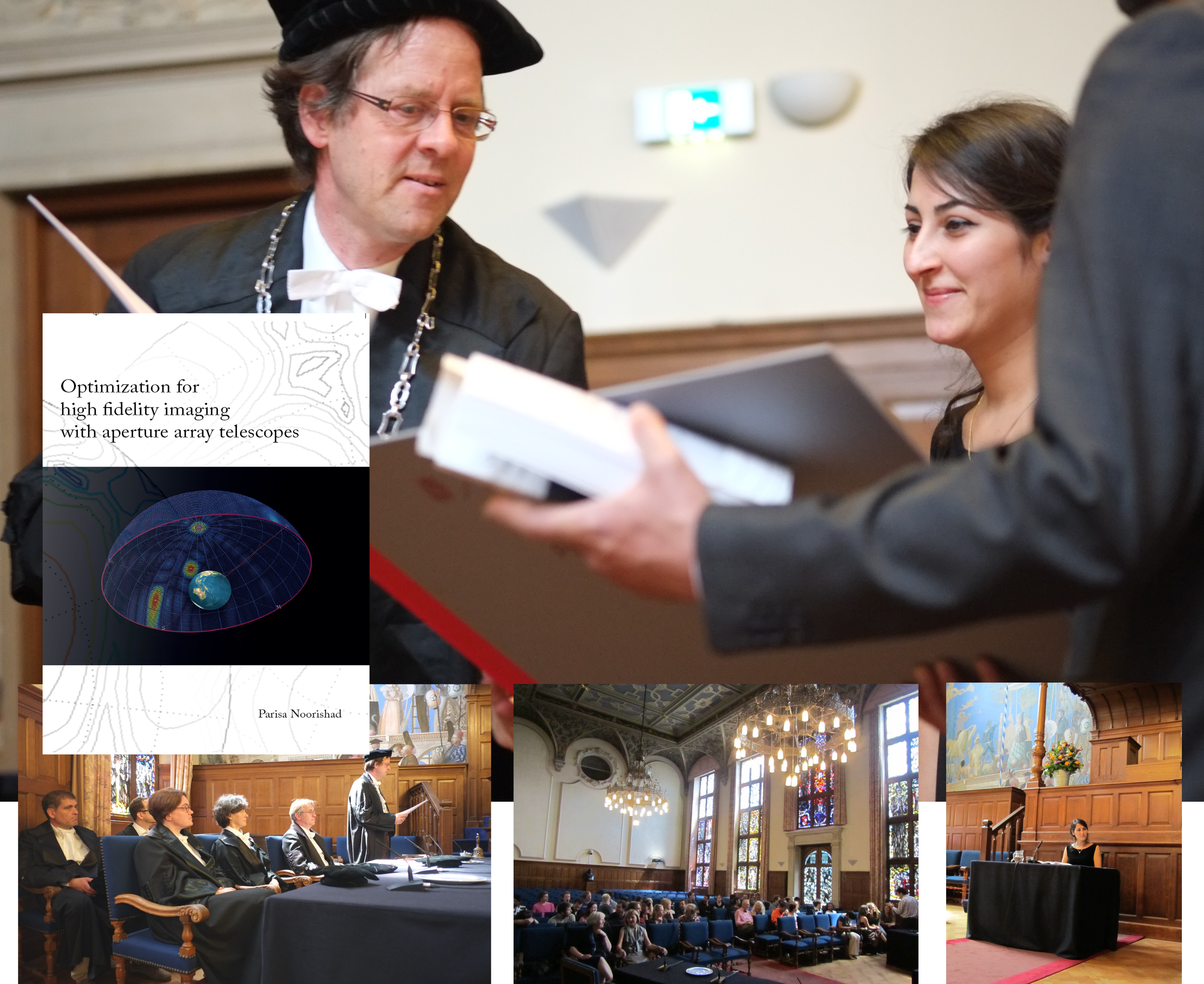 © Parisa Noorishad
© Parisa Noorishad
Called "Optimization for High Fidelity Imaging with Aperture Array Telescopes", the thesis addressed some key and fundamental issues relevant for the success of aperture arrays. She presented a fresh look on (limits of) redundancy in aperture arrays like LOFAR and activities toward their use in the SKA, suggested solutions of constrained self-calibration and optimal modelling for extended sources aiming to improve to high fidelity imaging. This is very relevant as the wide field potential of these arrays and the inevitable intense processing required, can only result in good imaging after fully understanding where we are in algorithmic speech, and what need to be done next and therefore the thesis is an excellent basis for further work. See http://irs.ub.rug.nl/ppn/358156297
Dr Noorishad is now working on processing software in the TARGET centre in Groningen tackling Big Data visualization issues. We wish her all the best in this emerging and also for radio astronomy, highly relevant field!